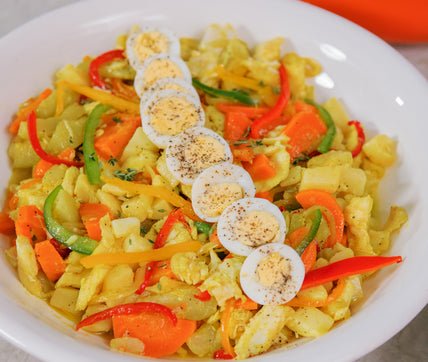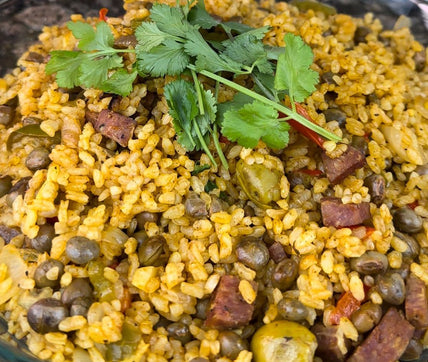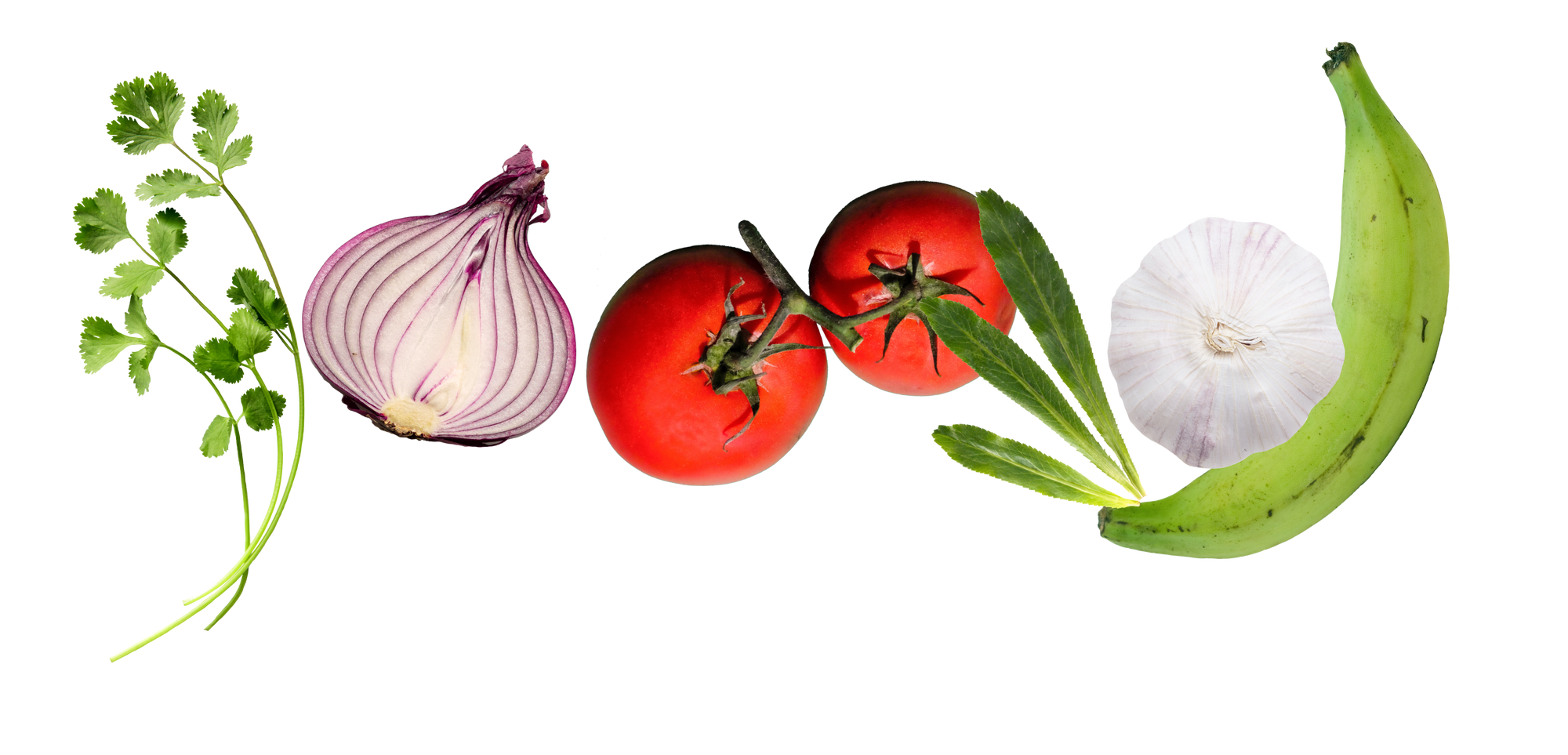
Pollo Guisado
Chicken stew inspired by my Puerto Rican grandmother, with a few of my own additions.
by Sami Abreu | @sami_ab
For me, Pollo Guisado is one of those dishes that feels like home. Next to sancocho, it’s the dish I request when my abuela asks me what I want her to cook when I visit. It’s a dish that warms you from the inside out and has the power to ground you and remind you who you are and where you came from through both happy times and heartbreaks. A few ladles of pollo guisado blanketed over a heap of perfectly cooked arroz blanco with a couple dashes of Red Devil hot sauce brings me to my grandmother’s kitchen in the Bronx, sitting around the counter table with my family bustling about and Caso Cerrado or a Yankee's game playing on the TV.
This dish is a testament to the age-old fact that poor people's food is often the best food. It’s a simple stew of chicken, carrots, and potatoes seasoned with all the good stuff that gives Caribbean food the savory, deep flavor that keeps you coming back for seconds and thirds: Sofrito, Sazón, and Adobo.

While Pollo Guisado was one of my favorite dishes growing up in a Puerto Rican household, my first attempt at making it myself only came about in the last few years – around the same time I made my first ever pernil for Friendsgiving in my first big girl New York City apartment. Unlike my first pernil, however, I did not use a recipe for my first Pollo Guisado. Instead, I played back the many memories of my grandmother making the dish in her kitchen, the many memories of me enjoying it by the spoonful, and figured that the recipe would make its way from deep within me out into the big stockpot on my tiny Williamsburg stove.
Through the process, I added my own little bits of myself – I swapped gold potatoes for calabaza or kabocha squash for a more complex flavor (who doesn’t love sweet and savory?) I added in a handful of leafy greens to sneak in some more nutrients, and to counter the addition of greens altogether, I used a slice of bacon instead of the more traditional ham – mostly because that’s all I could find at the time. As I write this, I wonder how much of my additions were a subconscious response to my college boyfriend asking me “why is all of your food brown?” after a few dinner sessions with my family. Either way, my pollo guisado feels like a natural evolution of my grandmother’s, and representative of my mixed experience growing up as a second generation latina.
Do not worry – for the purposes of this blog post, I won’t leave you to summon your own Pollo Guisado off of sheer vibes. I’ve put together a recipe with an ingredients list and directions and everything. Looking back on it, I don’t actually think this was how my grandmother made it at all. I have a memory of her boiling the potatoes and carrots entirely separately from stew and dropping them in once they became tender. But, I believe that traditions don’t need to be rigid to be meaningful. As long as we preserve the love and intention behind them, putting a little bit of ourselves into the pot is part of the magic of passing them along.

You will notice that I left the ingredient amounts flexible, that’s because sometimes you’re cooking Pollo Guisado for yourself, sometimes you’re cooking it for 6 of your friends in an AirBNB in the Catskills. I recommend starting on the lower end of measurements if you’re cooking just for 4 people or less, and going up if you’re serving a larger group. And, there are some things that only your heart can measure, and for me, that “some things” includes how much Sazón and Sofrito to add to the pot. I have given you a suggestion, but by all means, let your soul be your guide.
To start the process, you’ll want to brown the chicken in the bottom of the pot. This is not something my grandmother did, but I’ve watched enough Food Network throughout my life to know that the brown bits that appear at the bottom of the pot when you sear meat (otherwise known as fond) add a ton of flavor to the final dish. I like to season my chicken on both sides with Adobo, and I’d suggest using Loisa’s Organic Adobo for a purer, fresher flavor. Growing up, we always made Pollo Guisado with chicken legs. I opt for a mix of legs and thighs, but if you’d like, you can certainly use chicken breasts. If you have the time to simmer your stew for an hour or more, you could probably keep them whole, as more time renders the meat more tender to the point of falling apart. Otherwise, if you’re using chicken breasts and cooking for a shorter amount of time, you may like to cut them into 2-inch pieces. When it comes to chicken legs and thighs, a similar logic applies. The longer you cook the stew, the more tender the meat will become. The last few times I made this recipe, I let my guisado simmer for about two hours. The result was chicken so tender that the drumstick and thigh bones just slipped right out, so I removed them myself before serving.
As it relates to the additions, feel free to swap out or in whatever you like. Maybe you’re feeling sweet potatoes over kabocha squash, or maybe butternut is in season and you want to throw that in. Perhaps you even want to bring it back to the basics and go for gold potatoes, or even purple potatoes. Feel free to omit the addition of greens altogether, or try something different. I’ve made Pollo Guisado with swiss chard, collard greens, kale, and spinach – whatever is available to you and in season is fair game. Also, feel free to skip the bacon, or swap it for ham, or pancetta. I'll admit, once I even forgot to buy tomato sauce, so I had no option but to use ketchup instead. It still came out delicious and my previously mentioned 6 friends in the Catskills were none the wiser. You have the freedom to make this recipe yours the same way I made it mine.

One final note on the olives and capers. Growing up, I hated olives. I despised that they made their way into my empanadas, habichuelas guisadas, and bacalao. I’d pick through my plate and transport all of the olives I could find onto my sister’s – she loved olives. Now that I am a grown adult, I’ve taught myself to accept olives for what they are. They add a rounded flavor to so many of our heritage dishes, and I have to applaud them for that. Even so, I tend to opt for capers instead of olives. I’ve given you the option below in the ingredients, so you can choose either, or even both! If you’re looking for efficiency, you could use Loisa’s Sofrito Rojo for this dish, which already has olives and capers mixed in.

Now, I’ll let you get to it. I hope this recipe fills your heart as much as it fills mine. Eat it alone or with people you love. Eat it in Brooklyn in the fall, at a ski house in Colorado, or half a mile away from the beach in Puerto Rico. I suggest that you serve it over fluffy white rice with a slice of avocado, but my only hard rule is to cook it with intention, and put a little something of yourself in along the way.



